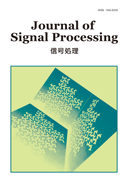Volume 28, Issue 6
Special Issue on Nonlinear Circuits, Communications and Signal Processing (Editor-in-Chief: Takashi Yahagi)
Displaying 1-8 of 8 articles from this issue
- |<
- <
- 1
- >
- >|
-
2024Volume 28Issue 6 Pages 257-265
Published: November 01, 2024
Released on J-STAGE: November 01, 2024
Download PDF (7477K) -
2024Volume 28Issue 6 Pages 267-275
Published: November 01, 2024
Released on J-STAGE: November 01, 2024
Download PDF (1950K) -
2024Volume 28Issue 6 Pages 277-283
Published: November 01, 2024
Released on J-STAGE: November 01, 2024
Download PDF (1754K) -
2024Volume 28Issue 6 Pages 285-292
Published: November 01, 2024
Released on J-STAGE: November 01, 2024
Download PDF (1477K) -
2024Volume 28Issue 6 Pages 293-299
Published: November 01, 2024
Released on J-STAGE: November 01, 2024
Download PDF (1416K) -
2024Volume 28Issue 6 Pages 301-307
Published: November 01, 2024
Released on J-STAGE: November 01, 2024
Download PDF (1767K) -
2024Volume 28Issue 6 Pages 309-313
Published: November 01, 2024
Released on J-STAGE: November 01, 2024
Download PDF (857K) -
2024Volume 28Issue 6 Pages 315-319
Published: November 01, 2024
Released on J-STAGE: November 01, 2024
Download PDF (967K)
- |<
- <
- 1
- >
- >|
